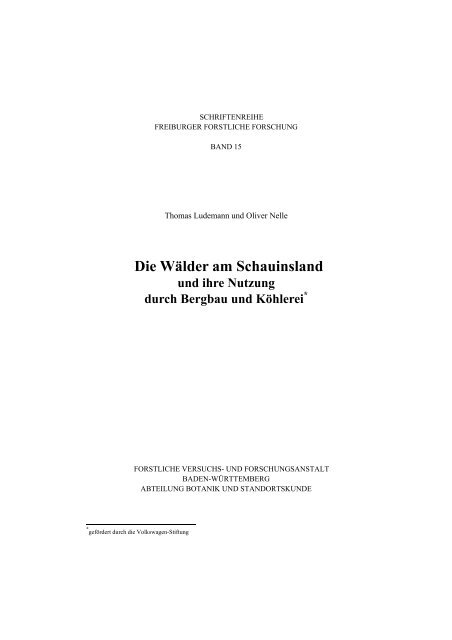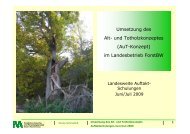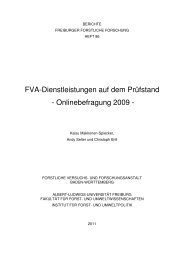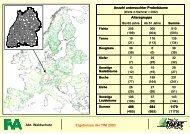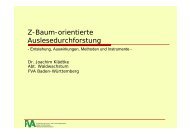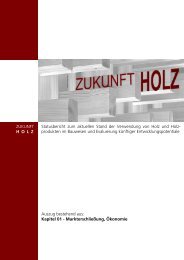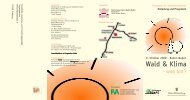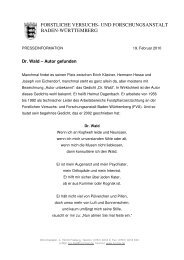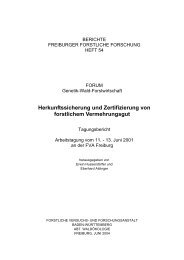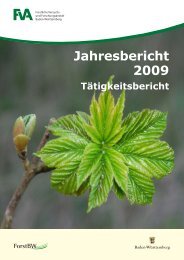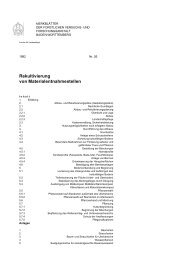Ludemann, T.; Nelle, O.: Die Wälder am Schauinsland - Forstliche ...
Ludemann, T.; Nelle, O.: Die Wälder am Schauinsland - Forstliche ...
Ludemann, T.; Nelle, O.: Die Wälder am Schauinsland - Forstliche ...
Sie wollen auch ein ePaper? Erhöhen Sie die Reichweite Ihrer Titel.
YUMPU macht aus Druck-PDFs automatisch weboptimierte ePaper, die Google liebt.
SCHRIFTENREIHE<br />
FREIBURGER FORSTLICHE FORSCHUNG<br />
BAND 15<br />
Thomas <strong>Ludemann</strong> und Oliver <strong>Nelle</strong><br />
<strong>Die</strong> <strong>Wälder</strong> <strong>am</strong> <strong>Schauinsland</strong><br />
und ihre Nutzung<br />
durch Bergbau und Köhlerei *<br />
FORSTLICHE VERSUCHS- UND FORSCHUNGSANSTALT<br />
BADEN-WÜRTTEMBERG<br />
ABTEILUNG BOTANIK UND STANDORTSKUNDE<br />
* gefördert durch die Volkswagen-Stiftung
<strong>Die</strong> Deutsche Bibliothek − CIP-Einheitsaufnahme<br />
<strong>Ludemann</strong>, Thomas und <strong>Nelle</strong>, Oliver:<br />
<strong>Die</strong> <strong>Wälder</strong> <strong>am</strong> <strong>Schauinsland</strong> und ihre Nutzung durch Bergbau und Köhlerei / Thomas<br />
<strong>Ludemann</strong> & Oliver <strong>Nelle</strong>. <strong>Forstliche</strong> Versuchs- und Forschungsanstalt Baden-Württemberg,<br />
Abt. Botanik und Standortskunde. [Hrsg.: Forstwissenschaftliche Fakultät der Universität<br />
Freiburg und <strong>Forstliche</strong> Versuchs- und Forschungsanstalt Baden-Württemberg]. −<br />
Freiburg (Breisgau): <strong>Forstliche</strong> Versuchs- und Forschungsanstalt Baden-Württemberg,<br />
2002<br />
(Schriftenreihe Freiburger <strong>Forstliche</strong> Forschung; Bd. 15)<br />
ISSN 1436-0586<br />
ISBN<br />
<strong>Die</strong> Herausgeber:<br />
Forstwissenschaftliche Fakultät der Universität Freiburg und<br />
<strong>Forstliche</strong> Versuchs- und Forschungsanstalt Baden-Württemberg<br />
Redaktionskomitee:<br />
Prof. Dr. J. Huss Prof. Dr. W. Konold<br />
Prof. Dr. G. Kenk Dr. H. Volk<br />
Umschlagestaltung:<br />
Bernhard Kunkler Design, Freiburg<br />
Druck:<br />
Eigenverlag der FVA, Freiburg<br />
Bestellung an:<br />
<strong>Forstliche</strong> Versuchs- und Forschungsanstalt Baden-Württemberg<br />
Wonnhaldestr. 4<br />
79100 Freiburg<br />
Tel. 0761/4018-0 Fax 0761/4018-333<br />
E-Mail: poststelle@fva.bwl.de<br />
Internet: http://www.fva-bw.de<br />
Alle Rechte, insbesondere das Recht der Vervielfältigung<br />
und Verbreitung sowie der Übersetzung vorbehalten.<br />
Gedruckt auf 100 % chlorfrei gebleichtem Papier
INHALTSVERZEICHNIS<br />
Inhaltsverzeichnis<br />
1 Einführung ............................................................................................................... 1<br />
Dank ............................................................................................................................. 2<br />
2 Untersuchungsgebiet............................................................................................... 3<br />
2.1 Lage, Naturraum, Wuchsbezirk ............................................................................ 3<br />
2.2 Topographie .......................................................................................................... 4<br />
2.3 Klima..................................................................................................................... 4<br />
2.4 Geologie, Geomorphologie................................................................................... 6<br />
2.5 Böden .................................................................................................................... 6<br />
3 <strong>Die</strong> natürlichen Vegetationsverhältnisse............................................................ 7<br />
3.1 Ergebnisse der Pollenanalyse................................................................................ 7<br />
3.2 Naturnahe Waldgesellschaften.............................................................................. 8<br />
3.2.1 Galio odorati-Fagetum, Waldmeister-Buchenwald.................................... 9<br />
3.2.2 Luzulo-Fagetum, Hainsimsen-Buchenwald............................................... 9<br />
3.2.3 Carici remotae-Fraxinetum, Winkelseggen-Erlen-Eschenwald ................. 10<br />
3.2.4 Fraxino-Aceretum, Linden-Ulmen-Ahornwald ......................................... 10<br />
3.2.5 Aceri-Fagetum, Bergahorn-Buchenwald ................................................... 10<br />
3.2.6 Luzulo-Abietetum, Hainsimsen-Fichten-Tannenwald............................... 11<br />
3.3 Der natürliche Anteil der Baumarten .................................................................... 11<br />
4 Siedlungs- und Nutzungsgeschichte .................................................................... 13<br />
4.1 Allgemeine Übersicht............................................................................................ 13<br />
4.2 Köhlerei (Exkurs).................................................................................................. 14<br />
4.2.1 Geschichte und Bedeutung ........................................................................ 14<br />
4.2.2 Leben der Köhler ....................................................................................... 16<br />
4.2.3 Technik der Köhlerei ................................................................................. 17<br />
4.2.4 Eigenschaften und Verwendung der Holzkohle......................................... 19<br />
4.3 Bergbau................................................................................................................. 20<br />
4.4 Anthropogene Vegetationsveränderung und holzkohleanalytischer Nachweis..... 22<br />
5 Fundplätze, Material, erfasste Nutzungen ........................................................ 25<br />
5.1 Kohlstätten, Meilerplätze ...................................................................................... 26<br />
5.2 Bergbaurevier St. Ulrich-Birkenberg .................................................................... 28<br />
5.3 Montanarchäologische Ausgrabungen .................................................................. 30<br />
5.3.1 Grabung St. Ulrich A 1987 ........................................................................ 30<br />
5.3.2 Grabung St. Ulrich C 1990 ........................................................................ 31<br />
5.3.3 Grabung St. Ulrich F 1992 ........................................................................ 31<br />
5.3.4 Grabung Birkenberg 1997/1998................................................................. 31<br />
5.4 Weitere mittelalterliche Arbeitsterrassen .............................................................. 32<br />
5.5 Sonstige Fundplätze .............................................................................................. 33
Inhaltsverzeichnis<br />
6 Methoden................................................................................................................... 35<br />
6.1 Probenahme, Fundplatzmerkmale......................................................................... 35<br />
6.2 Erfassung der aktuellen Vegetation....................................................................... 36<br />
6.2.1 Einzugsgebiet der Meilerplätze (Probekreise) ........................................... 36<br />
6.2.2 Waldgesellschaften .................................................................................... 36<br />
6.2.3 Baumartenanteile ....................................................................................... 37<br />
6.3 Holzkohleanalyse.................................................................................................. 37<br />
6.3.1 Genutzte Holzstärken, mD-Wert................................................................ 38<br />
6.4 Historische Quellen............................................................................................... 39<br />
6.5 Datierung der Holzkohleproben............................................................................ 39<br />
7 Ergebnisübersicht.................................................................................................... 41<br />
7.1 Vegetationserfassung ............................................................................................ 42<br />
7.1.1 Waldgesellschaften .................................................................................... 42<br />
7.1.2 Aktuelle Baumartenanteile......................................................................... 42<br />
7.1.3 Vegetationskarte Birkenberg und Umgebung............................................ 43<br />
7.2 Holzkohleanalyse.................................................................................................. 47<br />
7.2.1 Genutzte Holzarten .................................................................................... 47<br />
7.2.2 Genutzte Holzstärken................................................................................. 52<br />
7.2.3 Höhenprofil................................................................................................ 56<br />
7.2.4 Verteilung der Holzkohle in den Fundschichten und Bodenfraktionen ..... 56<br />
7.2.5 Probengröße............................................................................................... 62<br />
7.3 Kohlplatztypologie nach Platzgröße und Alter ..................................................... 64<br />
8 Ergebnisse der Teilgebiete..................................................................................... 67<br />
8.1 Bergbaurevier St. Ulrich-Birkenberg .................................................................... 68<br />
8.1.1 Aktuelle Vegetation − Waldgesellschaften und Baumarten....................... 68<br />
8.1.2 Holz und Holzkohle................................................................................... 68<br />
8.1.3 Historische Quellen.................................................................................... 71<br />
8.2 Teilgebiet 1 − Kohlernkopf................................................................................... 71<br />
8.2.1 Aktuelle Vegetation − Waldgesellschaften und Baumarten....................... 71<br />
8.2.2 Holzkohle................................................................................................... 72<br />
8.2.3 Historische Quellen.................................................................................... 74<br />
8.3 Teilgebiet 2 – Westliches Möhlintal ..................................................................... 76<br />
8.3.1 Aktuelle Vegetation − Waldgesellschaften und Baumarten....................... 76<br />
8.3.2 Holzkohle................................................................................................... 78<br />
8.3.3 Historische Quellen.................................................................................... 80<br />
8.4 Teilgebiet 3 − Östliches Möhlintal/Bohrer............................................................ 82<br />
8.4.1 Aktuelle Vegetation − Waldgesellschaften und Baumarten....................... 82<br />
8.4.2 Holzkohle................................................................................................... 84<br />
8.4.3 Historische Quellen.................................................................................... 86
Inhaltsverzeichnis<br />
8.5 Teilgebiet 4 – <strong>Schauinsland</strong>gipfel/Hundsrücken................................................. 87<br />
8.5.1 Aktuelle Vegetation − Waldgesellschaften und Baumarten..................... 87<br />
8.5.2 Holzkohle................................................................................................. 88<br />
8.5.3 Historische Quellen.................................................................................. 90<br />
9 Diskussion................................................................................................................ 95<br />
9.1 <strong>Die</strong> untersuchten Proben ..................................................................................... 95<br />
9.1.1 Probengröße............................................................................................. 95<br />
9.1.2 Verteilung der Holzkohle an einer Kohlstätte.......................................... 96<br />
9.2 Das Alter der Kohlplätze..................................................................................... 98<br />
9.3 Das verwendete Holz und das Vorgehen der Köhler .......................................... 100<br />
9.3.1 Holzartenselektion ................................................................................... 100<br />
9.3.2 Genutzte Holzstärken............................................................................... 105<br />
9.3.3 Sortierung der Chargen............................................................................ 107<br />
9.3.4 Holztransport ........................................................................................... 107<br />
9.3.5 Unterschiede der Nutzungsphasen und Teilgebiete ................................. 108<br />
9.4 Holzmangel und Walddegradation...................................................................... 110<br />
9.5 Rekonstruktion der historischen <strong>Wälder</strong> ............................................................. 112<br />
9.6 Holzkohlespektrum, Waldgesellschaft, Standort ................................................ 113<br />
9.6.1 Tanne und Buche ..................................................................................... 114<br />
9.6.2 Eiche und Hainbuche ............................................................................... 118<br />
9.6.3 Fichte ....................................................................................................... 118<br />
9.6.4 Erle und Pioniergehölze........................................................................... 119<br />
10 Zus<strong>am</strong>menfassung – Summary – Résumé ....................................................... 120<br />
10.1 Zus<strong>am</strong>menfassung............................................................................................. 120<br />
10.2 Summary ........................................................................................................... 122<br />
10.3 Résumé.............................................................................................................. 125<br />
11 Quellenverzeichnis ................................................................................................ 128<br />
11.1 Literatur............................................................................................................. 128<br />
11.2 Gemarkungspläne.............................................................................................. 139
120 Zus<strong>am</strong>menfassung – Summary – Résumé<br />
10 ZUSAMMENFASSUNG – SUMMARY – RÉSUMÉ<br />
10.1 ZUSAMMENFASSUNG<br />
Weite Teile des Schwarzwaldes wurden vor dem Einsetzen der planmäßigen Forstwirtschaft<br />
zur Holzkohleproduktion genutzt. An vielen Orten wurde zudem Bergbau betrieben.<br />
Auch bei der Nutzung der ausgedehnten Waldgebiete <strong>am</strong> Schwarzwald-Westabfall um den<br />
<strong>Schauinsland</strong> südlich von Freiburg haben Bergbau und Köhlerei in der Vergangenheit eine<br />
bedeutende Rolle gespielt. Es bestehen jedoch nur vage und ungenaue Vorstellungen darüber,<br />
welche Ausgangssituation die Bergleute und Köhler angetroffen und welchen Zustand<br />
sie hinterlassen haben, welcher Einfluss von ihnen ausging und welche Veränderungen<br />
durch ihre Aktivitäten bewirkt wurden. <strong>Die</strong> systematische holzanatomische Analyse<br />
von Rückständen der genannten Aktivitäten im Gelände, speziell von Holzkohleanreicherungen<br />
der ehemaligen Arbeitsstätten der Bergleute und Köhler, trägt dazu bei, die Kenntnisse<br />
über die entsprechenden Gegebenheiten und Vorgänge zu erweitern und zu präzisieren.<br />
Unter Einbeziehung vegetations- und standortskundlicher Daten werden darüber hinaus<br />
Aussagen zu den historischen und ursprünglichen Bestockungsverhältnissen abgeleitet.<br />
Im Ganzen wurde historisches Fundgut von 97 Fundplätzen einer holzanatomischen<br />
Analyse unterzogen, 15288 Holzkohlestücke und 14 Holzstücke, darunter insbesondere das<br />
Material eines gut erhaltenen mittelalterlichen Bergbaureviers, das bei archäologischen<br />
Ausgrabungen <strong>am</strong> Birkenberg bei St. Ulrich seit 1987 geborgen wurde. Bei dem bearbeiteten<br />
historischen Fundgut handelt es sich vor allem um Rückstände des mittelalterlichen<br />
Erzabbaus sowie der neuzeitlichen Holzkohleherstellung in stehenden Rundmeilern. Gesonderte<br />
Analysen erfolgten zusätzlich für einige dieser Fundplätze, im Hinblick auf methodische<br />
Fragestellungen zur Probenahme, zur Stichprobengröße und zur Verteilung der Holzkohle<br />
innerhalb einer Fundschicht und in verschiedenen Größenfraktionen des Bodens.<br />
Im Zuge der Probenahme wurden Geländemerkmale der Fundplätze, wie Lage, Größe<br />
und Zustand, aufgenommen. Parallel dazu wurden die heutigen Wald- und Standortsverhältnisse<br />
erfasst. Dazu wurde die aktuelle Vegetation, der heutige Anteil der Waldgesellschaften<br />
und der Baumarten, auf einer Ges<strong>am</strong>tfläche von 350 ha in der Umgebung der<br />
Fundplätze kartiert. <strong>Die</strong> bearbeiteten Fundplätze und Kartierungsflächen erstrecken sich<br />
über verschiedenste Waldstandorte auf einem Höhenprofil von fast 1000 m, zwischen 300<br />
und 1300 m ü. NN, vom Schwarzwald-Westrand bis zu den Hochlagen <strong>am</strong> Gipfel des<br />
<strong>Schauinsland</strong>s.<br />
In der aktuellen Vegetation herrschen Galio- und Luzulo-Fageten vor. Innerhalb der einzelnen<br />
Probekreise erzielen diese beiden Waldgesellschaften verschiedenste Anteile und<br />
kommen auch in verschiedensten Ausbildungen vor − submontan, montan, hochmontan,<br />
nährstoffreich, nährstoffarm, trocken, feucht. An Sonderstandorten mit entsprechend geringer<br />
Flächenausdehnung finden wir Waldgesellschaften mit Ahorn, Esche und Erle (Carici-<br />
Fraxinetum, Fraxino-Aceretum, Aceri-Fagetum). <strong>Die</strong> Fichte ist heute in den Probekreisen<br />
mit insges<strong>am</strong>t 44 % <strong>am</strong> Aufbau der Baumschicht beteiligt, Buche mit 37 % und Tanne mit<br />
12 %. In den submontanen und montanen Lagen trifft man manchenorts naturnahe Buchen-
Zus<strong>am</strong>menfassung – Summary – Résumé 121<br />
Tannen-<strong>Wälder</strong> an. In der submontanen Stufe beteiligt sich die Eiche <strong>am</strong> Aufbau der<br />
Baumschicht.<br />
In der historischen Holzkohle wurden fast alle von Natur aus zu erwartenden Gehölzarten<br />
gefunden, vor allem Buche (70 %) und Tanne (21 %), ferner Hainbuche und Eiche<br />
mit je 3 % und Pappel mit 1 % sowie mit Anteilen von jeweils unter 1 % Kiefer, Birke,<br />
Erle, Weide, Kirsche, Ahorn, Stechpalme, Hasel, Fichte, Kernobstgewächse, Linde und<br />
Ulme. Lediglich Esche konnte nicht nachgewiesen werden. <strong>Die</strong> Mengenanteile der Arten<br />
liegen im Ganzen in einer Größenordnung, die natürlichen Verhältnissen nahe kommt,<br />
wobei Tanne und Eiche (etwas) unterrepräsentiert erscheinen, Buche dementsprechend<br />
überrepräsentiert. <strong>Die</strong> Fichte fehlt im historischen Fundgut weitgehend und kommt nur<br />
ganz vereinzelt in den höchsten Lagen vor.<br />
<strong>Die</strong> generelle Bevorzugung einer bestimmten Holzart für die Holzkohleproduktion oder<br />
als Energieholz konnte nicht nachgewiesen werden. Im Gegenteil belegen die Befunde,<br />
dass die Köhler − mit Ausnahme von Esche − das ges<strong>am</strong>te natürliche Baumarteninventar<br />
zur Holzkohleherstellung verwendet haben. Für die einzelnen Fundplätze und die verschiedenen<br />
Nutzungsphasen wurden demgegenüber erhebliche Unterschiede festgestellt, sowohl<br />
bezüglich der genutzten Holzarten, als auch bezüglich der genutzten Holzstärken. <strong>Die</strong>se<br />
Unterschiede werden teils auf verschiedene anthropogene Einwirkungen, teils auf natürliche<br />
Standortsunterschiede zurückgeführt und für die verschiedenen Gebiete, Waldstandorte<br />
und Zeitabschnitte ausführlich diskutiert. Zus<strong>am</strong>menfassend können die folgenden<br />
Punkte hervorgehoben werden:<br />
− Wir können eine ältere Phase der Holznutzung unterscheiden – speziell im Hoch- und<br />
Spätmittelalter, aber sich bis in die frühe Neuzeit (16./17. Jh.) fortsetzend –, in der<br />
Laubholz, zum Teil mit kleinem Durchmesser, als Brennholz für viele Zwecke bevorzugt<br />
wurde.<br />
− Einzelne Proben, reich an Eiche, Hasel und Weide, zeigen, dass bergwerks- und siedlungsnah<br />
die Aktivitäten des Menschen zu einer Anreicherung dieser Arten vor dem<br />
späten Mittelalter geführt haben.<br />
− Neben der älteren Nutzungsphase, in der hauptsächlich Laubholz als Brennholz verwendet<br />
wurde, finden wir eine zweite, jüngere und professionellere Phase der neuzeitlichen<br />
Holzkohleproduktion, in der vor allem starke Tannen und Buchen genutzt wurden.<br />
− Hinweise auf Selektion bestimmter Baumarten oder Holzstärken in dieser zweiten Phase<br />
konnten nicht gefunden werden. Im Gegenteil kommen in den verschiedenen Kombinationen<br />
der genutzten Baumarten natürliche Unterschiede der Standorte zum Ausdruck.<br />
− <strong>Die</strong> Auswirkungen der älteren, selektiven Laubholznutzungen lassen sich erkennen und<br />
räumlich eingrenzen anhand der jüngeren Fundplätze der Köhlerei: Einige von ihnen,<br />
aber nicht alle, die nahe von Siedlungen und Bergwerken im Westteil des Untersuchungsgebietes<br />
liegen, sind besonders reich an Tannenholzkohle.<br />
Dass ein Holztransport aus der weiteren Umgebung zu den Fundplätzen hin stattgefunden<br />
hat, dafür lassen sich keinerlei Hinweise finden. Vieles spricht dafür, dass das Holz in<br />
der unmittelbaren Umgebung der Meilerplätze geschlagen wurde. Insbesondere kann aufgezeigt<br />
werden, dass das Artenspektrum der Holzkohleproben sowie die Mengenanteile der<br />
einzelnen Arten vielfach die Standortsverhältnisse der nahen Umgebung der Fundplätze
122 Zus<strong>am</strong>menfassung – Summary – Résumé<br />
widerspiegeln. Sowohl für die Anteile der Hauptbaumarten des regionalen Waldes, Buche<br />
und Tanne, als auch für das Vorkommen von Nebenbaumarten an bestimmten Sonderstandorten<br />
werden derartige Zus<strong>am</strong>menhänge aufgezeigt und erörtert. Ebensowenig lassen<br />
sich holzkohleanalytisch Hinweise auf Holzmangel und Walddegradation finden. Nur für<br />
die exponiertesten K<strong>am</strong>mlagen wird eine maßgebliche Verstärkung der natürlichen Standortsungunst<br />
durch den Weideeinfluss angenommen.<br />
Für die historischen Bestockungsverhältnisse lassen sich weitgehend Buchen-Tannenwälder<br />
rekonstruieren − mit verschiedenen Dominanzverhältnissen der beiden Baumarten,<br />
teils natürlich standörtlich bedingt, teils anthropogen: Besonders hohe Tannenanteile in den<br />
tiefen, siedlungsnahen Lagen werden auf vorangegangene selektive Brennholznutzungen<br />
zurückgeführt, die hohen Buchenanteile in den höchsten Lagen primär auf die besonderen<br />
standörtlichen Gegebenheiten dort, verstärkt durch anthropozoogenen Einfluss (Beweidung).<br />
Für das natürliche Vorkommen der Fichte belegen die Untersuchungen gerade auch<br />
für die höchsten Lagen <strong>am</strong> <strong>Schauinsland</strong>gipfel eine noch geringere Bedeutung, als bisher<br />
von vegetationskundlicher Seite angenommen wurde.<br />
Schlagworte: Anthrakologie, Bergbau, Großrestanalyse, Holzkohle, Köhlerei, Kohlplatz,<br />
Mittelalter, Neuzeit, potenzielle natürliche Vegetation, <strong>Schauinsland</strong>, Schwarzwald, St.<br />
Ulrich, Waldgeschichte, Waldgesellschaften, Waldnutzung, Waldstandort<br />
10.2 SUMMARY<br />
The forests of the <strong>Schauinsland</strong> area (Black Forest, Germany) and the history of their<br />
exploitation for mining and charcoal burning<br />
The Black Forest was intensively exploited for charcoal production in former times,<br />
before modern forest management systems began to work more efficiently. Moreover, at<br />
many places mining activities were undertaken. In the exploitation of the wide forest areas<br />
surrounding Mount <strong>Schauinsland</strong> south of Freiburg at the western fall of the Black Forest<br />
mining and charcoal burning were also of great importance in the past. But there are only<br />
vague and inexact ideas of the ancient situation and its changes, of the forests the miners<br />
and the charcoal burners met and of those they left behind, of the influence originated from<br />
their activities and of the changes which were effected.<br />
The systematic anthracological investigation of remains from the activities mentioned,<br />
especially from enrichments of charcoal at the former working places of the miners and<br />
charcoal burners, contributes to understanding the corresponding occurrences and processes<br />
more precisely. In comparing the results of charcoal analysis with those of vegetation<br />
science and with the present-day site conditions, we also try to deduce information on the<br />
former forest stands, on the natural forest vegetation and especially on the natural tree<br />
species combinations of the different forest sites and forest communities.<br />
We have analyzed charcoal s<strong>am</strong>ples from 97 sites of the <strong>Schauinsland</strong> area, including<br />
the material of a well-prepared medival mining area, excavated by the Institute of Archaeology<br />
of the University of Freiburg since 1987, and especially the material of many charcoal
Zus<strong>am</strong>menfassung – Summary – Résumé 123<br />
kilns and mine-smithies‘ forges. This material, altogether 15,288 pieces of charcoal and −<br />
because of the bad (terrestrial) preservation conditions − only 14 pieces of wood, mainly<br />
originating from charcoal production in upright circular kilns in Modern Times and from<br />
mining activities in the Central and Late Middle Ages, including complex settlement activities.<br />
Moreover, some sites have been investigated in a special way, focusing on methodological<br />
questions in s<strong>am</strong>pling design and in the distribution of charcoal pieces in one +/-<br />
homogeneous charcoal layer and in different soil fractions. The site conditions and the<br />
current forest vegetation, i. e. tree species combination and phytosociological forest communities,<br />
in the surroundings of each s<strong>am</strong>ple site were registered in a field study, along<br />
with the anthropogenic characteristics of the sites, like form, dimension and preservation<br />
conditions.<br />
The sites investigated range over an altitudinal gradient of nearly 1000 meters between<br />
300 m a. s. l., at the west border of the Black Forest, and nearly 1300 m a. s. l. at the top of<br />
Mount <strong>Schauinsland</strong>.<br />
Today the forest vegetation in the surroundings of the s<strong>am</strong>ple sites is dominated by<br />
beech-forest of more or less rich soils (Galio- and Luzulo-Fagetum). On special sites with<br />
correspondingly small square dimension we find forest communities with maple, ash and<br />
alder (Carici-Fraxinetum, Fraxino-Aceretum, Aceri-Fagetum). Today norway spruce (Picea<br />
abies) dominates in the tree layer, with 44 %, followed by beech (Fagus sylvatica, 37 %)<br />
and silver fir (Abies alba, 12 %). In the submontane forest belt, oak can participate in<br />
forming the tree layer.<br />
In the historical charcoal we found nearly all of the tree species to be expected for the<br />
natural conditions in the area investigated, mainly beech (Fagus sylvatica, 70 %) and silver<br />
fir (Abies alba, 21 %), additional tree species included hornbe<strong>am</strong> (Carpinus betulus) and<br />
oak (Quercus) with each 3 % and aspen (Populus) with 1 % as well as pine (Pinus), alder<br />
(Alnus), lime (Tilia), maple (Acer), cherry (Prunus), elm (Ulmus), hazel (Corylus), willow<br />
(Salix), spruce (Picea), birch (Betula) and mountain ash (Sorbus) or other Pomoideae. Only<br />
english ash (Fraxinus) could not be found.<br />
The frequencies of the different species found in the charcoal mirror a near-natural<br />
situation, whereby silver fir and oak seem to be (a little bit) underrepresented, beech<br />
accordingly overrepresented. Spruce is missing in most of the historical charcoal s<strong>am</strong>ples<br />
and only appears with few single pieces in the material of two of the highest sites (upper<br />
montane zone).<br />
A general preference for a distinct tree species for charcoal burning or for fuel wood is<br />
not to be found. On the contrary, we can give evidence that all of the tree species to be<br />
expected under natural conditions have been used, with the exception of ash (see above).<br />
But looking at the individual results from the different sites and from different phases of<br />
exploitation there are indeed many differences to be found in the historical charcoal, in the<br />
combinations and frequencies of the tree species being exploited, as well as in the di<strong>am</strong>eters<br />
of the wood exploited.<br />
These differences can be explained partly by anthropogenic influence, partly by natural<br />
site differences. They are discussed in detail for the different forest areas and forest sites
124 Zus<strong>am</strong>menfassung – Summary – Résumé<br />
investigated and for the different phases of exploitation. Summarizing, we can point out the<br />
following:<br />
− We can distinguish an older phase of wood exploitation − especially in the Central and<br />
Late Middle Ages but proceeding into Early Modern Times (16th & 17th centuries) −,<br />
where deciduous wood, partly with small di<strong>am</strong>eters, was preferred as combustibles for<br />
many purposes.<br />
− Single s<strong>am</strong>ples rich in oak, hazel and willow indicate that near settlements and mines<br />
human activities must have led to an enrichment of these species before the Late Middle<br />
Ages.<br />
− Besides the older exploitation phase, in which deciduous wood was mainly used as<br />
combustibles, we find a second, more recent and more professional phase of charcoal<br />
production in the Modern Age, in which large trees of silver fir and beech were predominantly<br />
used.<br />
− Indications for selection of distinct tree species or di<strong>am</strong>eters of wood in this second<br />
phase could not be found. On the contrary, the different combinations of tree species<br />
exploited reflect differences in the natural site conditions.<br />
− The effects of the older selective exploitation of deciduous wood can be recognized and<br />
spatially delimited by more recent sites of charcoal burning: A few of them, but not all<br />
− located near settlements and mines in the western part of the investigation area − are<br />
especially rich in charcoal of silver fir.<br />
There are no indications to be found of import of wood or charcoal into the investigation<br />
area. In many cases the wood for charcoal burning seemed to be cut in the near surroundings<br />
of the sites investigated, because the combination and frequency of tree species<br />
in the charcoal often reflect the site conditions of the vicinity of the sites. That bec<strong>am</strong>e<br />
evident in looking at both the frequencies of the main tree species of the regional forest<br />
communities, beech and silver fir, and the less frequent tree species of special sites. Just as<br />
little evidence is found in anthracological indications of shortages of wood or of serious<br />
forest degradation. Only the most exposed sites at the highest ridges may have been<br />
moderately degraded by grazing.<br />
In the past the investigation area was mainly covered by beech-fir forests with quite<br />
different frequencies of the (two) dominant tree species, partly naturally caused, partly<br />
anthopogenic: High values of fir in the low submontane belt and near settlements are traced<br />
back to previous selective fuel wood exploitations, high values of beech in the upper<br />
montane belt to the special natural site conditions, strengthened by anthropozoogenic<br />
influences (grazing). The role of Picea under near natural conditions apparently seems to be<br />
even more insignificant than has been expected up to now from the point of view of<br />
vegetation science – even on the highest sites.<br />
Keywords: ancient woodland, anthracology, Black Forest, charcoal burning, forest<br />
community, forest exploitation, forest history, kiln site, Middle Ages, mining, Modern<br />
Times, natural vegetation, site conditions
Zus<strong>am</strong>menfassung – Summary – Résumé 125<br />
10.3 RÈSUMÈ<br />
Les forêts de la région de <strong>Schauinsland</strong> (Forêt Noire, Allemagne) et leur utilisation par<br />
les industries minière et charbonnière<br />
Avant l’introduction de l’exploitation forestière planifiée, des secteurs importants de la<br />
Forêt Noire ont été consacrés à la production de charbon de bois. En de nombreux endroits,<br />
se rajoutait en outre une activité minière. Il en était ainsi autrefois des grands massifs<br />
forestiers de la partie Ouest de la Forêt Noire (Schwarzwald-Westabfall) autour du <strong>Schauinsland</strong><br />
au sud de Freiburg où les industries charbonnière et minière jouaient un rôle<br />
important. Il n’existe toutefois que des éléments incertains et approximatifs au sujet des<br />
conditions initiales que les charbonniers et les mineurs ont trouvées ainsi que de la situation<br />
qu’ils ont laissée derrière eux, de leur influence et des modifications provoquées par leurs<br />
activités.<br />
L’analyse anthracologique systématique des traces laissées par les activités précitées, en<br />
particulier de l’enrichissement en charbon de bois des anciens lieux de travail des mineurs<br />
et des charbonniers, contribue à augmenter et à affiner les connaissances sur les données et<br />
processus correspondants. Des connaissances au sujet des conditions historiques et originelles<br />
des peuplements pourront être déduites de l’étude de données relatives à la végétation et<br />
à la station.<br />
Des éléments historiques ont été recueillis suite à l’analyse anatomique du bois sur<br />
97 placettes ; 15288 morceaux de charbon de bois et 14 de bois, avec en particulier du<br />
matériel en provenance d’un site minier bien conservé datant du Moyen-Âge, mis au jour<br />
en 1987 lors de fouilles archéologiques au Birkenberg près de St Ulrich. Lors de l’analyse<br />
des éléments historiques il s’agit avant tout de reste de prospection du fer des activités<br />
minières du Moyen Âge ainsi que de la fabrication moderne de charbon de bois dans des<br />
charbonnières verticales.<br />
Des analyses spécifiques ont de plus été réalisées sur quelques unes des zones d’étude,<br />
suite à la réflexion (méthodologique) menée au sujet de la méthode d’inventaire, de la taille<br />
des placettes ainsi que de la répartition du charbon de bois au sein d’un horizon et dans<br />
divers compartiments du sol. Ces analyses ont été complétées par le relevé des caractéristiques<br />
de l’environnement des zones d’étude, telles leur localisation, leur taille et leur état.<br />
Les caractéristiques actuelles de la forêt et de la station ont été étudiée en parallèle. De plus,<br />
en périphérie des zones d’étude, la végétation actuelle, la part de chaque association<br />
forestière et de chaque essence forestière ont été cartographiées, le tout représentant une<br />
surface de 350 ha. Les zones d’étude et les secteurs cartographiés s’étendent sur les stations<br />
forestières les plus variées sur un dénivelé de presque 1000 m entre 300 et 1300 m audessus<br />
du niveau de la mer, de la partie Ouest de la Forêt Noire (Schwarzwald-Westrand)<br />
jusqu’aux secteurs sommitaux du point culminant du <strong>Schauinsland</strong>.<br />
Le Galio-Fagetum et le Luzulo-Fagetum prédominent dans la végétation actuelle. À<br />
l’intérieur de chaque placette, ces deux associations existent dans des proportions et des<br />
apparences les plus variées : sub-montagnard, montagnard, haute montagne, riche ou<br />
pauvre en substances nutritives, sec, humide. Sur des stations particulières d’étendue très<br />
limitée, on trouve des associations forestières comprenant de l’érable, du frêne et de l’aulne
126 Zus<strong>am</strong>menfassung – Summary – Résumé<br />
(Carici-Fraxinetum, Fraxino-Aceretum, Aceri-Fagetum). L’épicéa représente actuellement<br />
44 % du couvert forestier au niveau des placettes, le hêtre 37 % et le sapin 12 %. Dans les<br />
situations sub-montagnardes et montagnardes on rencontre en quelques endroits des<br />
hêtraie-sapinières subnaturelles. À l’étage submontagnard, le chêne est présent dans le<br />
couvert. Presque tous les types de bois auxquels on pouvait s’attendre naturellement ont été<br />
trouvés dans le charbon de bois de l’époque, en premier lieu le hêtre (70 %) et le sapin<br />
(21 %), suivi de loin par le charme et le chêne avec chacun 3 %, le peuplier avec 1 % ainsi<br />
que par le pin, le bouleau, l’aulne, le saule, le merisier, l’érable, le houx, le noisetier,<br />
l’épicéa, les fruitiers, le tilleul et l’orme dans des proportions inférieures à 1 %. Seule la<br />
présence de frêne n’a pas pu être démontrée.<br />
L’ordre de grandeur de la proportion de chaque essence correspond globalement à ce<br />
qu’on observe dans les conditions naturelles dans lesquelles le sapin et le chêne sont sousreprésentés,<br />
le hêtre en conséquence sur-représenté. L’épicéa manque dans la situation<br />
passée et n’apparaît que tout à fait sporadiquement dans les zones les plus élevées.<br />
L’usage prépondérant d’une essence déterminée pour la production de charbon de bois<br />
ou comme source d’énergie n’a pas pu être mis en évidence. Au contraire, les recherches<br />
prouvent que les charbonniers ont recouru à tout l’éventail d’essences naturelles pour la<br />
fabrication de charbon, à l’exception du frêne. Des différences importantes aussi bien en ce<br />
qui concerne les essences que les di<strong>am</strong>ètres utilisés ont été mises en évidence sur les différentes<br />
placettes et les différentes phases d'utilisation. Ces différences sont attribuées pour<br />
partie à diverses actions anthropiques et pour partie à des différences stationnelles ; ces<br />
différences sont ex<strong>am</strong>inées de manière détaillée pour les différents secteurs, stations et<br />
époques. En résumé, les points suivants peuvent être soulignés:<br />
− Nous pouvons identifier une phase très ancienne d’utilisation de bois - spécialement<br />
dans le haut Moyen Âge et le Moyen Âge tardif mais qui se prolonge jusqu’à la<br />
Renaissance (16/17 ème siècle) – caractérisée par l’emploi de bois de feuillu, pour partie<br />
de petit di<strong>am</strong>ètre, comme bois de feu pour des activités variées.<br />
− À proximité des mines et des lieux habités, différents échantillons riches en chêne,<br />
noisetier et saule mettent en évidence une montée en puissance de ces essences avant le<br />
Moyen Âge tardif en relation avec les activités humaines.<br />
− À côté de la phase d’utilisation la plus ancienne, dans laquelle le bois de feuillu a<br />
majoritairement été utilisé comme bois de chauffage, nous trouvons une seconde phase,<br />
plus récente et plus industrielle de la production moderne de charbon de bois, dans<br />
laquelle les gros bois de sapin et de hêtre ont principalement été employés.<br />
− Dans cette deuxième phase, des indications quant à l’usage préférentiel de certaines<br />
essences ou de certains di<strong>am</strong>ètres n’ont pas pu être trouvées. En revanche, les diverses<br />
combinaisons d’essences utilisées traduisent les différences stationnelles naturelles.<br />
− Les conséquences des utilisations sélectives les plus anciennes de bois de feuillu<br />
peuvent être mises en évidence et délimitées spatialement grâce aux placettes charbonnières<br />
les plus récentes : quelques-une d’entre elles, mais pas toutes, qui se trouvent<br />
à proximité de lieux habités et de sites miniers dans la partie occidentale du secteur<br />
d'étude, sont particulièrement riches en charbon de bois de sapin.
Zus<strong>am</strong>menfassung – Summary – Résumé 127<br />
Il n’existe aucun renseignement relatif au transport de bois vers les placettes à partir des<br />
environs. De nombreux éléments plaident en faveur de l’abattage d’arbres à proximité<br />
immédiate de la charbonnière. Il peut en particulier être démontré que les diverses essences<br />
de la placette de même que les proportions des différentes essences reflètent souvent les<br />
conditions stationnelles dans l’environnement immédiat des placettes. Des relations de ce<br />
genre seront mises en évidence et débattues, aussi bien en ce qui concerne les proportions<br />
en essences principales de la forêt régionale, hêtre et sapin, que la présence d’essences<br />
secondaires sur des stations déterminées. Il existe tout aussi peu de renseignements anthracologiques<br />
au sujet du manque de bois et de la dégradation des peuplements. Une dégradation<br />
des conditions stationnelles liée à l’influence du pâturage n’est admise que pour les<br />
crêtes les plus exposées.<br />
Concernant la reconstitution des peuplements historiques, on aboutit largement à la<br />
hêtraie sapinière – avec une dominance variable des deux essences, influencée pour partie<br />
naturellement par la station, pour partie par l’action humaine : les proportions particulièrement<br />
élevées de sapin dans les secteurs peu élevés proches des lieux habités sont attribuées<br />
à des usages sélectifs passés en tant que bois de feu ; les fortes proportions de hêtre dans les<br />
secteurs les plus élevés sont attribuées en premier lieu aux conditions stationnelles mais<br />
également à l’influence humaine (pâturage). Concernant la présence naturelle de l’épicéa,<br />
celle-ci semble encore bien moindre dans les secteurs les plus élevés des sommets du<br />
<strong>Schauinsland</strong> que ce qui était admis jusqu’à présent au vu des connaissances en matière de<br />
végétation.<br />
Mots-clés : activité charbonnière, activité minière, anthracologie, associations forestières,<br />
charbon de bois, exploitation forestière, Forêt Noire, histoire sylvicole, Moyen Âge, Nouvel<br />
Âge, peuplements forestiers, station forestière, végétation potentielle naturelle


